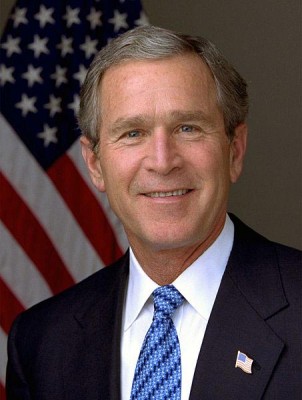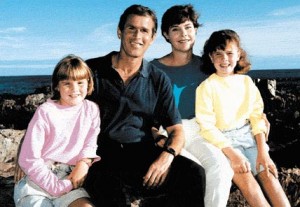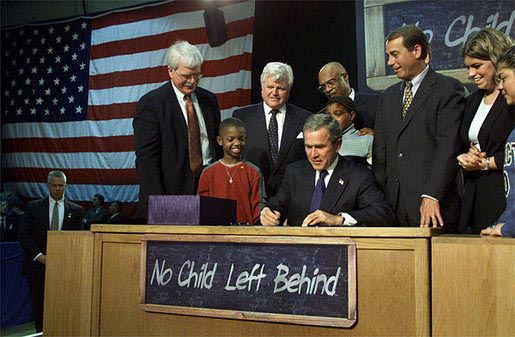| George W. Bush | |
|---|---|
 |
|
| 43rd United States President « Previous Next » |
|
| In office | Jan. 20, 2001 – Jan. 20, 2009 |
| V. President | Dick Cheney |
| Political Party | Republican |
| Personal Info | |
| Born | July 6, 1946 |
| Religion | Episcopalian United Methodist |
| School | Yale Harvard (M.B.A.) |
| Profession | Businessman Oil Baseball |
| Signature |  |
| Wife | Laura Bush |
| Children | Barbara Pierce Bush Jenna Welch Hager |
| U.S. Presidents 36-43 | |
| 36. Lyndon B. Johnson (1963-1969) | |
| 37. Richard Nixon (1969-1974) | |
| 38. Gerald Ford (1974-1977) | |
| 39. Jimmy Carter (1977-1981) | |
| 40. Ronald Reagan (1981-1989) | |
| 41. George H. W. Bush (1989-1993) | |
| 42. Bill Clinton (1993-2001) | |
| 43. George W. Bush (2001-2009) | |
| List of All the Presidents |
“The best hope for peace in our world was the expansion of freedom in all the world.” – George W. Bush
Very well known for his patriotic, brainy and sometimes funny quotes, George W. Bush was the president of the United States of America from January 20, 2001 up to January 20, 2009. This native of Houston, Texas was the only US president to have earned an MBA degree.
Early Life
Born on July 4, 1946, George W. Bush was the eldest son of George H. Walker Bush and Barbara Bush. Together with his four siblings, George spent his grade school years in Midland, Texas. He then finished his high school years at Phillips Academy in Massachusetts. It was on the year 1968 when he accomplished his Bachelor of Arts degree in History at Yale University.
After college, Bush was admitted for active duty-service training at the Texas Air National Guard. He then became a pilot two years after at the Ellington Air Force Base but was honorably discharged from service as an Air Force Reserve in November 1974. In 1973, Bush attended the Harvard Business School.
His Family and His Sources of Income
He got married to Laura Welch in November 5, 1977. They had two fraternal twin daughters in 1981, Barbara and Jenna. They lived together as a happy family in Midland, Texas while attending a United Methodist Church. Bush’s first run in politics in 1978 was not a success. He lost to Kent Hance by 6,000 votes for the House of Representatives battle at the Texas 19th Congressional District.
Bush began his business career in the oil industry in 1975. First was the Arbusto Energy, followed by the Spectrum 7 in 1984 and then the Harken Energy in 1988. He then became his father’s campaign advisor during the U.S. Presidential campaign from 1988 to 1991. Bush was also the managing director of a baseball franchise, the Texas Rangers, from 1989 to 1994. It was reported that Bush got an almost 2000% gain on this franchise when he sold it in 1994.
From Governor to President
 George W. Bush was the 46th governor of Texas from January 17, 1995 to December 21, 2000. Under the Republican Party, Bush defeated his opponent Ann Richards by a 7.6% margin. He was re-elected to the same position in the 1998 gubernatorial election. One of his very notable actions during Bush’s first term was the utilization of a budget surplus that cut $2 billion of Texas taxes. During his second term, his proclamation of June 10, 2000 as the Texas’ “Jesus Day” increased his approval ratings. It was also on this term when Bush decided to run for Presidency under the Republican Party after trailing his co-party opponent John McCain by 19% during the race for presidential nomination. He filed his formal candidacy at Concord, New Hampshire in the last months of 2000. Dick Cheney, a former Secretary of Defense, was Bush’s running mate. They both faced Al Gore, the Democratic Party’s presidential candidate. It was a very tough race between Gore and Bush even during the campaign period. But soon after the election in November 2004, Bush was declared the winner and the President of the United States of America after the very controversial 271 against 266 electoral votes in favor of him.
George W. Bush was the 46th governor of Texas from January 17, 1995 to December 21, 2000. Under the Republican Party, Bush defeated his opponent Ann Richards by a 7.6% margin. He was re-elected to the same position in the 1998 gubernatorial election. One of his very notable actions during Bush’s first term was the utilization of a budget surplus that cut $2 billion of Texas taxes. During his second term, his proclamation of June 10, 2000 as the Texas’ “Jesus Day” increased his approval ratings. It was also on this term when Bush decided to run for Presidency under the Republican Party after trailing his co-party opponent John McCain by 19% during the race for presidential nomination. He filed his formal candidacy at Concord, New Hampshire in the last months of 2000. Dick Cheney, a former Secretary of Defense, was Bush’s running mate. They both faced Al Gore, the Democratic Party’s presidential candidate. It was a very tough race between Gore and Bush even during the campaign period. But soon after the election in November 2004, Bush was declared the winner and the President of the United States of America after the very controversial 271 against 266 electoral votes in favor of him.
The Early Challenges of His Presidency
 Bush’s first year as a president was not as good as expected. The September 11, 2001 World Trade Center and Pentagon terrorist attack shocked not only Bush’s administration but also the whole world. It was considered the worst terrorist attack in the history of the United States after the World War II. In the same year, Bush laid down to the public his plan for a $1.3 trillion tax cut program. He based his plan from his own estimate that there would be an approximate $5.6 trillion surplus over the next ten years. Alan Greenspan, Chairman of the Federal Reserve that time, warned Bush that by executing the plan, the United States was more likely to face recession in the next five to ten years. The worst financial crisis struck the U.S. in 2007, six years after the implementation of the first tax cut program. Bush first three years in service was, however, a significant success on the overall economy. But years after that there the very alarming declines in Dow Jones and the employment rate, alongside an increase in poverty rates and national debt. The total national debt in 2008 was $11.3 trillion while the unemployment rate after Bush’s presidency was 7.2%. In 2008, there were 2.6 millions jobless Americans in the United States. The $170 billion economic stimulus package signed by Bush in 2007 didn’t work as expected either.
Bush’s first year as a president was not as good as expected. The September 11, 2001 World Trade Center and Pentagon terrorist attack shocked not only Bush’s administration but also the whole world. It was considered the worst terrorist attack in the history of the United States after the World War II. In the same year, Bush laid down to the public his plan for a $1.3 trillion tax cut program. He based his plan from his own estimate that there would be an approximate $5.6 trillion surplus over the next ten years. Alan Greenspan, Chairman of the Federal Reserve that time, warned Bush that by executing the plan, the United States was more likely to face recession in the next five to ten years. The worst financial crisis struck the U.S. in 2007, six years after the implementation of the first tax cut program. Bush first three years in service was, however, a significant success on the overall economy. But years after that there the very alarming declines in Dow Jones and the employment rate, alongside an increase in poverty rates and national debt. The total national debt in 2008 was $11.3 trillion while the unemployment rate after Bush’s presidency was 7.2%. In 2008, there were 2.6 millions jobless Americans in the United States. The $170 billion economic stimulus package signed by Bush in 2007 didn’t work as expected either.
The President on His Service to the Nation
 It was on January 2002 when Bush signed into law the No Child Left Behind Act. Many considered this initiative to increase the level of education in the country as a success. During his second the Medicare Drug Benefit Program, also known as the Medicare Act of 2003, was signed into law. The State Children’s Health Insurance Program was however opposed and vetoed by Bush in 2007. His visions of pursuing the reforms in the Social Security measures were declined by the U.S. Congress in 2005. Another crisis tested the President’s strength in 2005, when Hurricane Katrina struck the north-central Gulf Coast of the United States. His proposal of privatizing the Social Security System was further diminished.
It was on January 2002 when Bush signed into law the No Child Left Behind Act. Many considered this initiative to increase the level of education in the country as a success. During his second the Medicare Drug Benefit Program, also known as the Medicare Act of 2003, was signed into law. The State Children’s Health Insurance Program was however opposed and vetoed by Bush in 2007. His visions of pursuing the reforms in the Social Security measures were declined by the U.S. Congress in 2005. Another crisis tested the President’s strength in 2005, when Hurricane Katrina struck the north-central Gulf Coast of the United States. His proposal of privatizing the Social Security System was further diminished.
Bush was in opposition of the Kyoto Protocol, a United Nation’s proposal to combat global climate change, though he believed that global warming really exists. But despite of that, he amended the Clear Skies Act in 2002. His declaration of the 84 million acres of marine reserve in the Northwestern Hawaiian Islands as a national monument was a very significant move for the protection the environment. Bush worked on the expansion of the domestic oil production instead of relying on foreign oils. This was made visible when he lifted the ban on offshore drilling in 2008. In parallel to that, his administration kept on researching ways in order to reduce the country’s demand for oil by promoting several gas-saving programs and technologies. In the same year, Bush committed to $2 billion in support to the United Nation’s international programs of reducing the greenhouse gasses, fighting climate change and promoting clean energy resources and technologies.
On immigration issues, Bush supported the Comprehensive Immigration Reform Act that aimed to legalize the programs for many undocumented immigrant in the United States mostly coming from Mexico and the nearby Latin countries. Bush first used his veto power in 2006 when he vetoed the Stem Cell Research Enhancement Act five years after lifting the ban on the federal funding of adult stem cell research. Amidst Mother Nature’s fury in 2005 in the form of a hurricane, Bush declared the State of Emergency on Louisiana, Mississippi, Alabama and New Orleans showed that his administration was seriously taking full responsibility of national emergency situations. Despite of several criticisms that the emergency handling was a failure on the part of the government, his Department of Homeland Security Secretary Michael Chertoff, with his authority, created and declared the use of the National Response Plan that time.
Bush’s War Against Terrorism
 Bush launched the War on Terrorism months after the 9-11 attack. Part of the plan was the invasion of Afghanistan and Iraq. The mission was to destroy the Taliban, to dismantle the Al-Qaeda network headed by the notorious Osama bin Laden, and to remove Saddam Hussein from power in Iraq. Bush declared war against Iraq in 2003. Focusing on eliminating the threat of nuclear energy as weapon for mass destruction, Bush asserted in 2002 that North Korea, Iran, and Iraq constituted the “axis of evils” that was threatening the peace of the world. The U.S. Armed Force’s invasion of Iraq operation was still on-going up to this year as most critics are saying that there had been a continuous civil war in Iraq. With the successful coalition effort of 20 nations, including the United Kingdom, Bush however considered that the April 29, 2003 felling of Baghdad could be considered the end of the major combat operations in Iraq. It was on January 2005 when the first in 50 years democratic elections in Iraq took placed, making Nouri al-Maliki the new Prime Minister and Jalal Talabani the President. In January 2007, the number of troops deployed in Iraq surged by 21, 500 more. In 2008, Bush declared the withdrawal of a certain number of American Forces in the country.
Bush launched the War on Terrorism months after the 9-11 attack. Part of the plan was the invasion of Afghanistan and Iraq. The mission was to destroy the Taliban, to dismantle the Al-Qaeda network headed by the notorious Osama bin Laden, and to remove Saddam Hussein from power in Iraq. Bush declared war against Iraq in 2003. Focusing on eliminating the threat of nuclear energy as weapon for mass destruction, Bush asserted in 2002 that North Korea, Iran, and Iraq constituted the “axis of evils” that was threatening the peace of the world. The U.S. Armed Force’s invasion of Iraq operation was still on-going up to this year as most critics are saying that there had been a continuous civil war in Iraq. With the successful coalition effort of 20 nations, including the United Kingdom, Bush however considered that the April 29, 2003 felling of Baghdad could be considered the end of the major combat operations in Iraq. It was on January 2005 when the first in 50 years democratic elections in Iraq took placed, making Nouri al-Maliki the new Prime Minister and Jalal Talabani the President. In January 2007, the number of troops deployed in Iraq surged by 21, 500 more. In 2008, Bush declared the withdrawal of a certain number of American Forces in the country.
In Bush’s campaign against terrorism, the Military Commission Act of 2006 was signed, allowing the U.S. government to prosecute captured enemy combatants by military procedures instead of by standard trial. A big part of this law expansion was the authorization of Bush’s interrogation tactics, the most controversial of which was the waterboarding. On the other hand, Bush’s commitment to the total prevention of nuclear weapons led North Korea to shut down its nuclear reactors in May 2007. The first ever assassination attempt to George W. Bush happened on May 10, 2005 at Tbilisi, Georgia when a Georgian native in the name of Vladimir Arutyunian threw a live hand grenade toward the podium where he was speaking.
Declining Popularity that Made Him Stronger
During his two terms, Bush has maintained an average approval rating of 50%. He was named by the Time Magazine as its Person of the Year both in 2000 and 2004. However, Bush received the lowest approval rating of 24% in October 2007. His disapproval rating of 69% in April 2008 was the highest ever recorded in the 70-year history of any American President. These poor records were then followed by several independent surveys and polls the most notable of which was the 2010 Siena College poll of presidential scholars which ranked him as the 39th out 43 presidents with poor ratings in running the country.
The results of these findings later on led Representative Dennis Kucinich to introduce 35 articles of impeachment against Bush in June 9, 2008. Bush’s declining popularity even extended to the international community. A survey in 2007 indicated that Bush’s presidency had a negative implication for world security. Well known leaders of other countries during his time openly criticized the president for his global anti-war and anti-globalization campaigns. The most significant was the tension that arose between him and Russia leader Vladimir Putin. Another survey in 2007 showed that Bush was the most disliked leader in the Arab countries.
Bush’s Significant Achievements in the History of the United States
 President Bush was known to embrace the Catholic Doctrine. An unprecedented visit to Pope Benedict XVI in June 2008 led to speculation that Bush would convert to Roman Catholicism. And despite the many negative criticisms that Bush received during his term, this symbolic head of the state action earned him respect from many religious nations up. Bush’s presidency was not a as much a mistake as most of his critics thought. An article written for him in 2009 cited Bush’s ten greatest achievements in his eight years in the White House. Among of these achievements were: terminating the Kyoto Global Warming treaty in 2001, enhanced interrogation tactics on captured terrorists, the rebuilding of the degraded presidential authority during Bill Clinton’s presidency, his support for the peace process in Israel, the nationwide education reform No Child Left Behind bill, the prescription drug benefit enacted in 2003, the strengthening of the United States relation with east Asian democracies, and his courageous efforts in rebuilding the lost democracy of Iraq.
President Bush was known to embrace the Catholic Doctrine. An unprecedented visit to Pope Benedict XVI in June 2008 led to speculation that Bush would convert to Roman Catholicism. And despite the many negative criticisms that Bush received during his term, this symbolic head of the state action earned him respect from many religious nations up. Bush’s presidency was not a as much a mistake as most of his critics thought. An article written for him in 2009 cited Bush’s ten greatest achievements in his eight years in the White House. Among of these achievements were: terminating the Kyoto Global Warming treaty in 2001, enhanced interrogation tactics on captured terrorists, the rebuilding of the degraded presidential authority during Bill Clinton’s presidency, his support for the peace process in Israel, the nationwide education reform No Child Left Behind bill, the prescription drug benefit enacted in 2003, the strengthening of the United States relation with east Asian democracies, and his courageous efforts in rebuilding the lost democracy of Iraq.
George W. Bush After His Presidency
Bush, after his eight long years as the President of the United States of America, returned to his homeland in Midland, Texas. Bush and his family settled down in Dallas, Texas. Being a low profile ex-president, he managed to write and publish a book entitled “Decision Points” in 2010. This book later on made him a motivational speaker. Bush considered his book as his biggest accomplishment in keeping the country safe amid a real danger. Together with former President Bill Clinton, bush significantly raised contributions for the relief and recovery of the 2010 Haiti earthquake victims. Bush is currently an active public speaker.